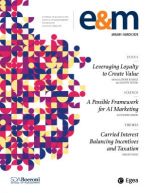Search
Applied filters:
Refine search
- Keyword
- customer loyalty (3)
- innovation (3)
- artificial intelligence (2)
- loyalty (2)
- GenAI (1)
- KPI (1)
- advanced data analytics (1)
- augmented marketing (1)
- Subject
- Accounting & control (2)
- Content type
- Journal article (8)
- Language
- English (1)

From Theory to Practice: Critical Factors in AI Implementation
By investigating major trends in the literature on artificial intelligence, this article provides an up-to-date, structured overview of AI applications in the business context. In particular, it explores the most influential factors in AI implementation, divided into five main areas: drivers for adoption, skills needed for implementation, risks and challenges, key business processes where AI is applied, ...

Authenticity Generates Uniqueness, Trust, and Loyalty
A brand is authentic when different stakeholders (employees, shareholders, customers, suppliers, etc.) feel that there is an alignment between declared values and objectives and concrete actions, inside the company and on the market. A strong, differentiated company culture contributes to a strong, differentiated brand, driven by the same purpose and values (Yohn, 2017). The brand is therefore ...

Personalizing the Product, but with Moderation
Traditionally, for the high-end consumer, the value of a product typically stems from its high price and limited accessibility, including in terms of distribution, generally accompanied by superior quality and a legitimacy often deeply rooted in the brand's heritage, that is, its history, that is extraordinarily important to confer desirability to the goods or services and boost the self-esteem of ...

The Strategic Power of Customer Relationships: Leveraging Loyalty to Create Value
Companies need to manage their customer base according to loyalty-based logic, focused on building and maintaining loyal relationships that stand the test of time. This reality has long been underscored by the shift from transactional to relationship marketing. The digital revolution has fueled and accelerated this transition, redefining the structure and competitive mechanisms of many industries ...

Replace, Add, Augment: A Possible Classification Framework for AI Marketing
Introduction The development of artificial intelligence, and in particular generative AI (GenAI), has turbocharged the transformation of marketing processes. But what exactly is GenAI? Let’s start by defining AI. The most common view in the literature describes it as the set of technologies, algorithms, and models (that is, machines broadly defined) designed to emulate human functions such as learning, ...

From States of Mind to Strategies Using the Moods Matrix
Mood can be defined as a semi-persistent psychophysical state that influences attitudes and behavior (Oxford Dictionary). Before beginning our discussion of this topic, we first need to recognize the difference between emotions, feelings, and moods, which mainly depends on their temporal sequence. In other words, emotions are the first to manifest as immediate reactions to perceived stimuli; feelings ...

The TCC Model: Turning Data Into Competitive Advantage
TCC is a company that specializes in creating loyalty programs and innovative marketing solutions to help companies build lasting and meaningful relationships with their customers. With an international presence, the company has been a reference partner for many retailers for over thirty years, combining innovation and operational excellence. TCC's mission is to create value through effective loyalty ...

Godfather Marketing: A New Approach with Risks and Rewards
According to the prevailing academic definition, the strategic goal of marketing is to "create value" for both the firm and consumers (cf. Gundlach and Wilkie, 2009), where "value" is understood as something that is objectively beneficial to both parties. However, it could be argued that the ultimate purpose of firms is to sell products, while for consumers it is to fulfill their needs – needs that ...